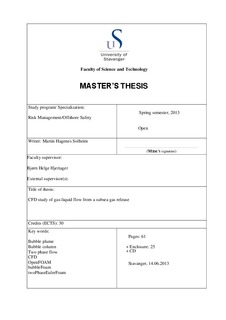| dc.description.abstract | The worlds demand for oil and gas is constantly increasing, and this has lead the exploration into deeper water. Introducing exploration in deep-water, poses new challenges when it comes to consequence modeling of blowouts or releases of gas from subsea pipelines. It is important to understand how the gas will disperse as it moves up through the water in what is recognized as a bubble plume. In todays practice, the fate of the released gas is often based on old experiments (Fanneløp and Sjøen, 1980) and a number of assumptions. These experiments suggest a good understanding of what goes on in shallow water, but there are a number of factors that can complicate the situation in deep-water. These assumptions are usually recognized as legit for water depths up to 300m, although this limit is questionable. As the exploration moves into water depths significantly deeper than 300 meters, these assumptions cannot be considered legit any more. In the industry, methods based on these assumptions are being used for large transient releases and/or deep-water. When consultancy firms are simulating scenarios of subsea releases of gas, they will either use formulas based on Fanneløp and Sjøen (1980), or integral models for the subsea part of the release. When the gas reach the surface they will normally use numerical simulation for the spreading of the released gas. As the computer hardware is developing rapidly, the potential of numerical simulation using computational fluid dynamics (CFD) tools is increasing. The CFD codes have also been undergoing a lot of research and development in the later years. When considering this, it could be of interest to evaluate whether numerical simulation can be used for the gas-liquid flow resulting from underwater blowouts or pipeline breakage.
The objective of this thesis was to use the open source CFD code OpenFOAM to set up an ideal bubble plume for comparison against experiment. I wanted to set up four cases in both 2D and 3D similar to the experiment of Fanneløp and Sjøen (1980) in a 10 meter pool. The parameters of particular interest were vertical velocity, plume radius and concentration of gas. The goal was to see if OpenFOAM could provide realistic results for 10 meter water depth. These results should provide a basis for further discussion on the potential of numerical simulation of bubble plumes. The results of the simulations had some similarities to the experiments. The slip velocity shows promising agreement with the theory. On the other hand, the most important parameters are clearly under-predicted. The spreading of the plume and the entrainment of water is on average about half of what is reported in the experiments. This leads to a higher void fraction, on average a factor of 2. This is believed to be affected by the turbulence model used, the boundary conditions and inherent limitations in the bubbleFoam solver. Other limitations were the settings set by the user. Also the velocity profile along the centerline is clearly over-predicted in the simulations. This is believed to be affected by the same things mentioned above, but also the constant bubble diameter of 3mm used.
Some alternative approaches are at the end considered to further test the potential of OpenFOAM. The cases are run laminar and with a changed inlet condition. They show a good tendency when comparing against the experiments.
Based on the information gained through this thesis, the conclusion is that we must rely on integral models today and for the foreseeable future, especially for practical use in the industry. The immediate focus should be on lecturing the industry on the clear limitation inherent in the basic relation based on Fanneløp and Sjøen (1980). That being said, research into numerical simulation of bubble plumes should also be prioritized. The challenge is to include non-ideal gas behavior, effects of cross currents, dissolution of gas and so forth. Also models that can include bubble breakage and coalescence should be considered. | no_NO |
